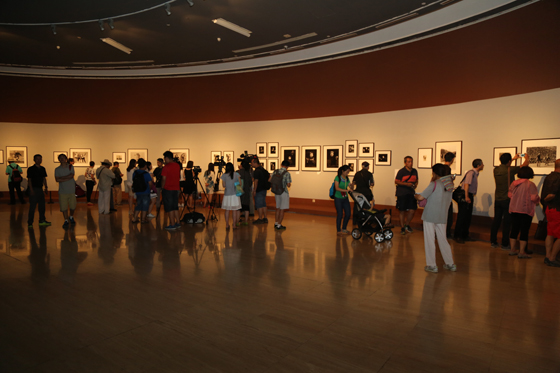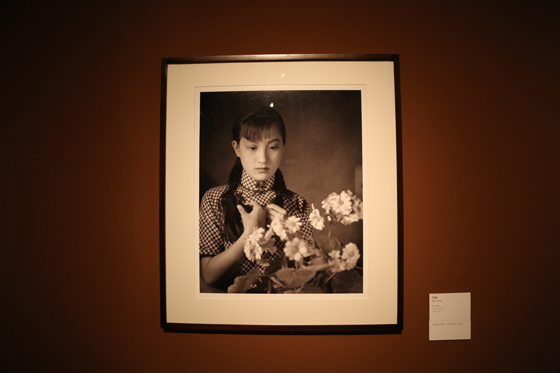History in Light and Shadow – Photography Exhibition Commemorating Wu Yinxian’s 115th Birthday opens in National Art Museum of China
Source:: Time:2015年07月23日
History in Light and Shadow – Photography Exhibition Commemorating Wu Yinxian’s 115th Birthday, sponsored by the National Art Museum of China, is one of the series exhibitions of the museum to commemorate the 70th anniversary of the victory of Chinese People’s War of Resistance Against Japanese Aggression and the World anti-Fascist War. It is also one of the series collection projects of the museum, known as Image China – Chinese Famous Photographers in 20th Century. The exhibition opened in the National Art Museum of China on July 8, 2015.
The exhibition took the artistic characteristics at different periods of Wu Yinxian’s photographic career as the clue, to show the sincere artistic feelings and lasting artistic charms of Wu with over 230 pieces of photographic and video materials in the three parts of First Exploration of Art · Rise to Fame with Images (1920-1937), Record the Time · Witness History (1938-1946), and Follow the Heart with Light and Shadow · Progression of Seasons (1947-1994).
Wu, even-aged with the 20th century, left many splendid photographic works. The National Art Museum of China had the honor to sponsor History in Light and Shadow – Photography Exhibition Commemorating Wu Yinxian’s 115th Birthday on the occasion of Wu’s 115th birthday. It was 30 years since the National Art Museum of China had held Photography Exhibition Celebrating Wu Yinxian as Photographer for 60 years in 1985. This exhibition made a comprehensive, full review of Wu’s photographic career, with substantial support of experts, scholars and institutions in the photographic circle. During the exhibition, Wu’s family donated 150 pieces of Wu’s photographic works to the National Art Museum of China. These works fully presented the characteristics and achievements of Wu in artistic creation in various periods. Enriching the research sequence of the museum in collection of 20th century photographic works.
Wu, born in 1900 in a common intellectual family in Shuyang, Jiangsu Province, was heavily influenced by his father who was going after new ideas and supporting social changes when he was a child. He showed sympathy for people in the bottom, and pursued freedom of thought and progress. In 1920, he entered Shanghai College of Fine Arts, learning western painting. In this period, he taught himself photography, and participated in exhibitions of Shanghai Black and White Photography Society. In the early stage of exploring the photographic art, he emphasized photography composition and experiments with the black and white tones. He was the cinematographer of the movies Children of Trouble Times (the theme song March of the Volunteers, with lyrics by Tian Han and music composed by Nie Er, was later set as the national anthem of the People’s Republic of China), and Angels on the Road. In 1938, Wu went to Yan’an to shoot the documentary Yan’an and the Eighth Route Army. As a young artist of considerable accomplishments influenced by the Left Wing ideology, Wu was touched by the Yan’an atmosphere which was very different from Shanghai. He abandoned the original plan to return to Shanghai after finishing the documentary, and stayed in Yan’an for revolutionary fiml work. He served as cinematography team chief and head of the film studio, making remarkable artistic achievements in the Party’s news documentary films and photography undertakings. In 1949, he took office in Northeast China Film Studio. In 1955, he was shifted to Beijing Film Academy, serving as vice-president and dean of the photography department. He made significant contributions to the development of New China photographic art and education.
Wu, an artist to record the time with cameras and video cameras, left behind many works of light and shadow to witness the history of Chinese revolution and progress of modern society. His name and works were engraved in people’s memory as well as the history of Chinese photography. Wu, with dedication and enthusiasm to life and art, created a lot of photographic works full of the spirit of the times, and showed sinecere feelings of older generation photographers towards life and dedication to the art. Morning Market (1923), the extant earliest photographic work of Wu, presented age-old city gate suffused with morning mist. With wet and slippery stone road, and the figures of people bustling about for sustenance against the strong backlight, the work sent forth rich local flavor and humanistic care. The important achievements of Wu in early stage photographic art exploration were films shot in the 1930s. he came into contact and was influenced by the left-wing ideology. Wu’s artistic creation showed up inclinations to criticize social reality, and pursue social and ideological innovation. In the late 1930s and 1940s, Wu, as a battlefield photographer, took a wealth of documentary pictures on leaders of the Communist Party of China, government and the military, important events, historical events, as well as series of photos on Yan’an political, military, economic, cultural and social life. They were of high artistic and historical values in Chinese photographic history and Chinese revolutionary history. Wu, with the unique perspective of a photographer, witnessed history. His revolutionary documentary works during the Yan’an period, such as Camel Bells (1938), Dr. Bethune (1939), Yan’an After Japanese Bombing (1938-1940), Arduous Pioneering (1942), Yan’an Forum on Literature and Art (1942), and Chongqing Negotiations (1945), recorded in multiple layers, the chapters of the Communist Party of China leading the people to fight against Japanese aggression and save the nation. Wu’s works showed patriotic Yan’an army and people and their fearless struggling spirit, rather than the bloody war scenes. As we are commemorating the 70th anniversary of the victory of the Chinese People’s War of Resistance Against Japanese Aggression and the World Anti-Fascist War, Wu’s photographic works of the red theme will bring us to look back at the difficult war years, go over the high spirit of soldiers to fight for the victory of the revolution, and thus get moved by the Yan’an spirit that struggle endlessly for new social ideals and liberty of the nation in the war times. His photographic works in the 1960s on militiawoman of New China and Yellow Mountain landscapes have also become classic, showing his profound artistic accomplishment as an older generation photographer.
Wu devoted himself to the photographic undertaking all his life. While mirroring the society, he also threw himself to photography education. During the Yan’an period, he chaired teaching tasks for two sessions of photography training courses. When he was 50, he threw himself heart and soul into education, making great contribution to put the people’s film cause back on track in New China, establish a comprehensive teaching system for the photography department of Beijing Film Academy, talent cultivation and innovation of Chinese photography technologies. He also wrote theoretical works totaling over one million words throughout his educational career. They were key components of Wu’s life of photographic art.
When the opening ceremony ended, the National Art Museum of China invited a dozen of research scholars from the photographic and cultural circles for academic discussion of Wu’s photographic art course and works. It also held lectures and public education activities, chaired by guest photographers, to entertain audiences.
The exhibition lasted till 12:00 July 16.




